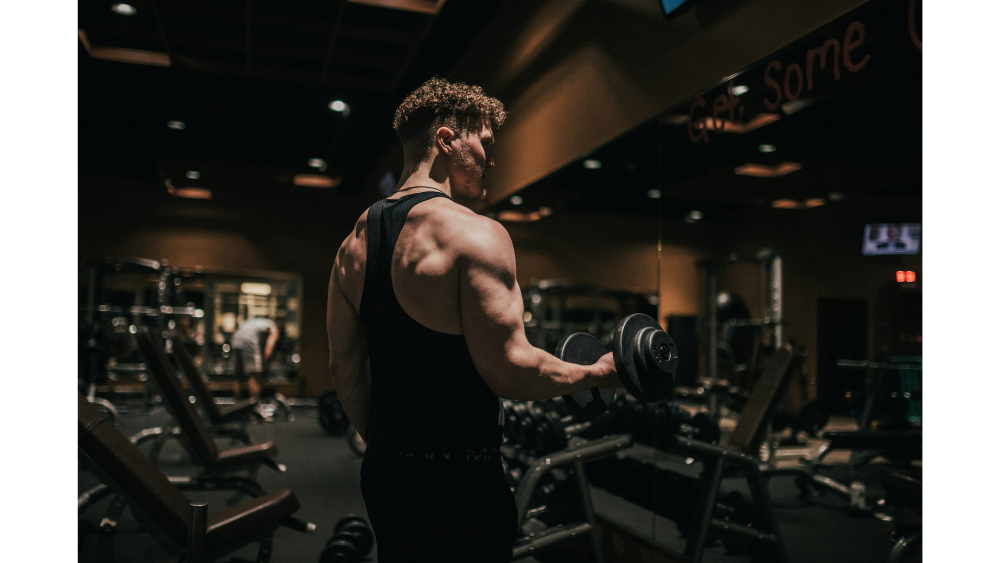POV: You are scrolling Instagram and you come across Mr. Olympia running a marathon in under 3 hours with motivational music and a speech about being a hybrid athlete.
In 15 seconds, you witness what could potentially be peak male performance. These athletes look strong, perform well, and show us that we do not have to choose between having big muscles or running far.
But what exactly are these “hybrid athletes?” How do they train? What do they eat? HOW DO THEY DO IT?
The Definition of Hybrid Athlete
One definition of the word “hybrid” means: of mixed character; composed of different elements (Oxford Dictionary).
A hybrid athlete is an athlete who trains both strength and endurance, testing their physical fitness and always pushing their limit.
The hybrid athlete trains in different elements which results in an athlete equipped for any event at any time.
Another definition given by Alex Viada in 2013 in a book called “The Hybrid Athlete’ is – “
The concurrent training of different athletic disciplines that do not explicitly support one another, and whose disparate components are not essential to success in any one sport” – Alex Viada
If you want to become the worlds strongest man or the worlds fastest runner, hybrid training may not be exactly for you; but if you want to be in the best physical shape of your life then I and many others recommend becoming a hybrid athlete.
What is the Goal of a Hybrid Athlete?
The main goal of a hybrid athlete, through strength and endurance training, is to achieve peak male performance. This dual focus allows the athlete to excel in various physical demands, making them versatile in their training, performance, and everyday life.
Often you will see hybrid athletes set goals both in the gym and outside of the gym. Goals in the gym can be seen as a 600-pound deadlift or a 405-pound bench press. Goals outside of the gym can be seen as completing a marathon in under 4 hours. Ultimately, all of these goals lead to the main goal which is to be a well-rounded, high-performing athlete.
As a man, father, or husband you should be physically capable of whatever challenge comes your way even if it is as small as having to carry your child up the stairs to bed.
Why Are Athletes Hesitant to Start a Hybrid Training Program?

There are many points made from both sides of the fitness community as to why they do not want to start hybrid training. They shy away from hybrid training for reasons you may have already heard before.
Bodybuilding Community
One of the biggest concerns in the bodybuilding community is that hybrid training will have a negative impact on their ability to build muscle. This is commonly known as the ‘interference effect’ which in the bodybuilding world means cardiovascular training will affect and stunt muscle hypertrophy negatively.
Running Community
A concern in the running community is that adding strength training to their workouts will cause an increase in muscle mass that will slow them down and take away their flexibility.
Does the Interference Effect Actually Exist?
A study done in the 1980s by RC Hickson shows something very interesting.
There are 3 groups of athletes, the strength group (S), the endurance group (E), and the hybrid group (H). For 10 weeks the S group strictly completed resistance training. The E group strictly completed aerobic training. The H group did both resistance and aerobic training.
The Results
This study shows that the S group saw an increase in strength gains from resistance training but no increase in VO2max (endurance capacity). The E group saw an increase in their VO2max but no increase in strength.
The H group saw the same increase as the E group in their VO2max as well as the same increase in strength as the S group up until week 7. It was evident in weeks 9 and 10 that the strength improvement in the H group began to level off and decline in comparison to the S group.
Why Should I Start Hybrid Athlete Training?

People ask this question all the time. The only correct answer to respond with the question “What are your goals?” If your goals align with the results of hybrid training then by all means become a hybrid athlete. If they do not, stick to what you were doing before.
If you have these goals you should consider a hybrid program:
8 Goals That Align with Hybrid Training
- Improve overall fitness: Enhance both strength and endurance for better everyday performance.
- Participate in obstacle course events: Train for events like Spartan races or other obstacle courses that require both running and strength.
- Achieve specific strength benchmarks while maintaining endurance: Set goals such as a 500-pound deadlift or a 300-pound squat alongside endurance benchmarks.
- Complete a marathon while maintaining strength: Build the endurance to run longer distances while maintaining strength training.
- Develop functional strength: Increase the ability to perform everyday activities, such as lifting heavy objects or moving quickly through functional fitness.
- Enhance athletic performance in various sports: Train for sports that require a mix of speed, agility, and strength, such as rugby or football.
- Lose or maintain weight: Utilize a combination of strength training and cardiovascular work to achieve the desired body composition.
- Boost mental resilience: Push physical limits to build mental toughness and resilience, preparing for challenges both in and out of the gym.
- Be challenged in a new area in your physical fitness: If your endurance is weak but you have great strength and vice versa, challenge yourself in a new area and become a more well-rounded athlete.
What if I Have No Goals? READ THIS!!!
Even if you currently have no clear fitness goals, hybrid training will be incredibly beneficial for you.
Hybrid training brings more to the table than big muscles, new personal bests for the half marathon, and an overall healthy lifestyle. It contributes to developing essential life skills such as discipline and resilience. The diverse demands of this form of functional training challenge individuals to establish a structured routine that requires commitment and maintaining a balance. This dedication births discipline, teaching athletes to stick to their training schedules, manage their time effectively, and push through periods of fatigue or self-doubt.
Push Beyond Your Limit
The journey of a hybrid athlete can sometimes be filled with setbacks, whether it be an unanticipated injury or a plateau in performance. Navigating these challenges cultivates resilience, as individuals learn to adapt, find alternative strategies, and remain focused on their long-term goals. This mental fortitude extends beyond the gym, enriching personal and professional areas of life by instilling a strong work ethic, problem-solving skills, and the ability to tackle obstacles head-on.
What Does Hybrid Training Look Like?

Hybrid athletes, as you already know, train with a balance of endurance and strength training. Hybrid training is not doubling the workouts and adding more strain to your body; it is a balance of both endurance and strength training.
Find the Balance, DO NOT ADD ON TOP OF!
If you previously did strength training for 6 days a week and desire to incorporate more endurance training, you would find a balance and add endurance training while also dialing back on the strength training. This could look like 4 days of strength training and 2 days of endurance training a week or depending on your goals 3 days of strength training and 3 days of endurance training a week. This is not adding high-intensity interval training on top of the high-intensity strength sessions you already have.
How do I Start Hybrid Training?
No matter what your goal is as a hybrid athlete, here are 4 easy steps to help lay the foundation and achieve your goal.
1 | Write Down Your Goal
Write down your goals to establish your ambitions and keep as a tangible reminder of what you are to conquer.
2 | Commit to Your Goal
Find or create a training plan that works for your goal and commit to it. The best thing you can do for yourself is be consistent and to do that is to be committed.
3 | Record Your Progress
It is important to record your progress for both strength and endurance training. This is to optimize progressive overload in the gym and on the track so you can develop into a stronger and faster athlete.
For strength training, record the number of sets, reps, and weights you did an exercise for. For example: Benchpress for 3 sets of 8 reps with 135lbs.
For endurance training, record how many miles you run a week in total and increase the number of miles you run a week by 5%-10%. You can also record the amount of time it takes to complete a mile or other distance.
4 | Recover
As a hybrid athlete, your body undergoes a combination of stress from both strength and endurance training, creating the need for proper recovery to prevent overtraining and injury. Prioritizing recovery allows your muscles to repair and grow stronger, enhancing your abilities in both areas of training.
This includes not only scheduled rest days but also active recovery sessions, proper hydration, balanced nutrition, and quality sleep. Listening to your body is essential; recognizing signs of fatigue or soreness can guide you on when to push harder and when to take a step back. By respecting the recovery process, you will maintain optimal performance levels and support your long-term fitness goals.
TRY THIS HYBRID TRAINING SPLIT TO START
Track your training volume and make adjustments as needed to optimize your workouts! Be smart about the way you train; do not overload the same muscle groups and energy systems.
| MONDAY | CHEST AND BACK / EASY RUN | OR | PUSH / RUN |
| TUESDAY | SHOULDERS AND ARMS | OR | PULL |
| WEDNESDAY | LEGS | OR | LEGS |
| THURSDAY | PUSH / EASY RUN | OR | REST |
| FRIDAY | PULL | OR | SHOULDERS AND ARMS / RUN |
| SATURDAY | RUN | OR | CHEST AND BACK / CONDITIONING |
| SUNDAY | REST | OR | REST |
Feel free to change this split around to what works for you. Reach out to us if you would like something more personalized for you!
Frequently Asked What is a Hybrid Athlete Questions

What is meant by hybrid athlete?
A hybrid athlete is an individual who trains both strength and endurance, aiming to excel in multiple physical domains rather than specializing in just one. This approach allows them to develop well-rounded fitness, enhancing overall performance by combining the benefits of weight training with cardiovascular conditioning.
Can anyone be a hybrid athlete?
Yes, anyone can become a hybrid athlete, regardless of their current fitness level or background. The essence of hybrid training lies in its adaptability, allowing individuals to tailor their routines to suit their personal goals and capabilities.
Whether you are a seasoned athlete or just starting your fitness journey, adopting a hybrid training approach can help you improve overall fitness, increase strength, and boost endurance. The key is to start gradually and listen to your body, progressively incorporating elements of both strength and endurance training.
Do hybrid athletes run everyday?
Hybrid athletes do not run every day. The frequency of running largely depends on individual goals, recovery needs, and the balance of strength training incorporated into their routine. Many hybrid athletes may opt to run several times a week, integrating rest days and active recovery sessions to allow their bodies to repair from both endurance and strength workouts. The intensity and frequency is up to you.
Conclusion

In conclusion, becoming a hybrid athlete opens up a world of opportunities for enhancing fitness and performance across multiple dimensions. By embracing a balanced approach to training that integrates both strength and endurance components, individuals can achieve their personal fitness goals while developing a resilient body and mind. Whether you’re pushing through a tough strength workout or enjoying a long run, the principles of hybrid training allow for versatility and adaptability in your fitness journey.
Remember, the key to success lies in setting clear goals, committing to consistent progress, and prioritizing recovery, which together ensure sustained improvements and long-term well-being. With determination and the right strategy, anyone can thrive as a hybrid athlete, unlocking their full potential in both strength and endurance.
Citations
Hickson, R C. “Interference of strength development by simultaneously training for strength and endurance.” European journal of applied physiology and occupational physiology vol. 45,2-3 (1980): 255-63. doi:10.1007/BF00421333
White, Georgia. “What on Earth Is a ‘Hybrid Athlete’?” Built for AthletesTM, Built for AthletesTM, 27 Mar. 2024, builtforathletes.com/blogs/news/what-on-earth-is-a-hybrid-athlete.

Leave a Reply